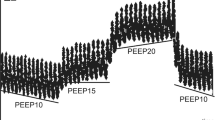Abstract
Intrapleural distribution of a dye bolus (0.4-0.6 ml, once 1 ml) let in through a cannula in the 10th right intercostal space (ics) was studied in anesthetised, breathing (N = 6) and apneic (N = 5) dogs in the left lateral posture. Rapid movements of the dye were detected through «windows» of endothoracic fascia in the 8th and 6th ics; overall distribution of the dye was assessed at autopsy 12 to 25 min after its entrance. In all dogs dye moved first to the caudal border of the lung following the direction of the diaphragmatic fibers, rather than the shortest route. Then dye moved along the caudal border of the lung mainly ventrally, reaching occasionally the ventral tip of the middle lobe. In some breathing dogs dye reached the «window» in 8th ics within few sec. In all but one breathing dogs dye reached also the margin between the middle and caudal lobe. No other parts of the visceral and corresponding parietal pleura were stained. Distribution pattern was not systematically different after 12 or 25 min. These findings validate the hypothesis that a small liquid bolus let in the pleural space is drawn to the lobar edges (Agostoni and D’Angelo, 1969).
Riassunto
La distribuzione intrapleurica di un bolo di colorante (0,4-0,6 ml, in un caso 1 ml) introdotto nel 10° spazio intercostale (ics) destro attraverso una cannula è stata studiata in cani respirant! (N = 6) e apneici (N = 5) in decubito laterale sinistro. I movimenti rapidi del colorante sono stati rilevati attraverso «finestre» di fascia endotoracica in 8° e 6° ics; la distribuzione complessiva del colorante è stata determinata all’autopsia eseguita da 12 a 25 minuti dopo l’introduzione del bolo. In tutti i cani il colorante raggiungeva dapprima il bordo caudale del polmone seguendo la direzione delle fibre diaframmatiche, non la via più breve. Il colorante procedeva quindi lungo il bordo caudale del polmone soprattutto in direzione ventrale, raggiungendo talvolta la punta ventrale del lobo medio. In alcuni cani respiranti il colorante raggiungeva la «fincstra» in 8° ics in pochi secondi. In tutti i cani respiranti, eccetto uno, il colorante arrivava anche al margine tra i lobi medio e caudale. Nessuna altra parte della pleura viscerale, o della corrispondente parietale, era colorata. La distribuzione del colorante non era sistematicamente diversa dopo 12 o 25 minuti. Questi risultati convalidano l’ipotesi secondo cui un piccolo bolo liquido introdotto nello spazio pleurico va ai margini lobari (Agostoni e D’Angelo, 1969).
Similar content being viewed by others
References
Agostoni E., D’Angelo E., 1969.Thickness and pressure of the pleural liquid at various heights and with various hydrothoraces. Respir. Physiol., 6: 330–342.
Agostoni E., 1972.Mechanics of the pleural space. Physiol. Rev., 52: 57–128.
Agostoni E., Zocchi L., Agostoni P. G., Macklem P. T., 1989a.Pleural pressure from abdominal to pulmonary rib cage: sweep of the lung border. Respir. Physiol., 75: 105–116.
Agostoni E., Agostoni P. G., Zocchi L., 1989b.Pleural liquid pressure in the zone of apposition and in the lung zone. Respir. Physiol., 75: 357–370.
Christensen G. C., Evans H. E., 1979.Miller’s Anatomy of the Dog. Philadelphia, Saunders.
Kampmeier O. F., 1928.Concerning certain mesothelial thickenings and vascular plexuses of the mediastinal pleura, associated with histiocyte and fat-cell production, in the human newborn. Anat. Rec., 39: 201–213.
Miserocchi G., Agostoni E., 1971.Contents of the pleural space. J. Appl. Physiol., 30: 208–213.
Miserocchi G., Negrini D., Foglio Para A., Pistolesi M., Miniati M., Bellina R., Giuntini C., 1986.Kinetics of the intrapleural distribution of a radioactive bolus. Respir. Physiol., 65: 13–27.
Miserocchi G., Pistolesi M., Miniati M., Bellina C. R., Negrini D., Giuntini C., 1984.Pleural liquid pressure gradients and intrapleural distribution of injected bolus. J. Appl. Physiol., 56: 526–532.
Mixter R. L., 1941.On macrophagal foci («milky spots») in the pleura of different mammals, including man. Am. J. Anat., 69: 59–185.
Author information
Authors and Affiliations
Additional information
Nella seduta dell’11 novembre 1992.
Rights and permissions
About this article
Cite this article
Zocchi, L., Agostoni, P.G., Agostoni, E. et al. Intrapleural distribution of a liquid bolus let in the costophrenic sinus. Rend. Fis. Acc. Lincei 4, 51–58 (1993). https://doi.org/10.1007/BF03001184
Issue Date:
DOI: https://doi.org/10.1007/BF03001184




